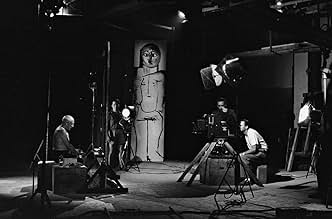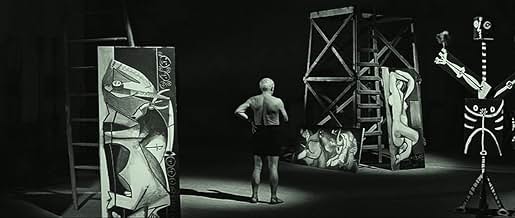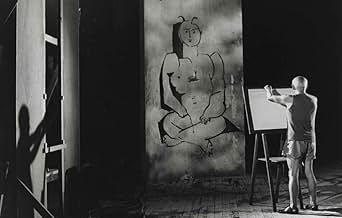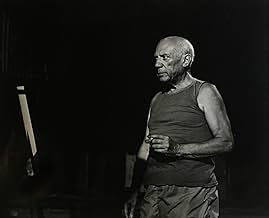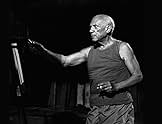PUNTUACIÓN EN IMDb
7,5/10
2,8 mil
TU PUNTUACIÓN
Añade un argumento en tu idiomaA filmed record of Pablo Picasso painting numerous canvases for the camera, allowing us to see his creative process at work.A filmed record of Pablo Picasso painting numerous canvases for the camera, allowing us to see his creative process at work.A filmed record of Pablo Picasso painting numerous canvases for the camera, allowing us to see his creative process at work.
- Dirección
- Reparto principal
- Premios
- 1 premio y 1 nominación en total
Pablo Picasso
- Self
- (as Picasso)
Henri-Georges Clouzot
- Self
- (sin acreditar)
Claude Renoir
- Self
- (sin acreditar)
Reseñas destacadas
I've always known that Pablo Picasso was one of the most prolific characters of the 20th century. I've also heard about how this film was made many times before, that is with the translucent screen between the camera and Picasso. At the beginning I thought that it was a bit slow and I remember wondering if I was in the midst of 2 hours of Picasso drawing picture after picture. And indeed it was, with a few breaks where we actually see and hear Picasso interact with the camera men. But, amazingly, once you get into watching the short drawing exercises, it becomes very captivating. You aren't sure what he's drawing, and then a line and a squiggle later it is a bull or a woman or whatever. The most mesmerizing part though, as another writer said, was when he was painting the beach scene and he kept painting over his work over and over again. What he was painting over was amazing and it made you wonder why he felt like it just didn't work.
If there was one word to describe this film for me, it would be "inspirational". And I think anyone who practices art or appreciates the process of art, can find this film enjoyable to watch. The film's title speaks for itself. We are engaged in an experimental documentary watching a prodigy at work and trying to unravel the magic of how it all happens. In the beginning there is a voice-over narrated introduction to the film, "Nobody knew what Rimbaud thought of when he wrote the poem "the drunk boat"." And then we realize that we are in for a real treat. Who would ever guess that the master of cubism would allow us to see his creative ideas at work? Most artists are very stubborn about this sort of thing, but then again most famous artists are also pretty ego-centric. The film places the camera behind a canvas that leaves the image transparent so that we can see the painting process without looking over the shoulder. There is a beautiful classical score along with this film and as the drawings progress, Picasso then takes on bigger challenges with paintings. The pacing is just right where the drawing process starts slow and then the strokes become faster with time-lapse photography. There is an amazing moment where the cameraman warns Picasso that he is about to run out of film. Picasso asks how many feet is left and calculates the timing of his painting and just at the last second, Picasso transforms the entire piece into something unexpected and radically different. We can see the spontaneity and playfulness in his work. The end is a mural shaped painting that evolves through many stages until Picasso says something like "its ruined. I have ruined the painting and yet at the same time, its improving." This is an indication of Picasso's fearless drive. When he paints, he is on fire. He works diligently for hours. Its fascinating to see little figures that he will paint over and over with more detail or more color. He wants to emphasize details that seem so ambiguous and its as if he's saying to the audience "look at this" "keep looking at this" "this is important." I first saw this film in the theater when I was about ten or twelve years old. I'm glad my family friends took me to see this. It has inspired me throughout the years. I saw the film again when I was twenty-four and it was just as I remembered it. After it was over, I did the same thing I did when I first saw the film; I pulled out a sketchbook and started drawing. This film is a real treat.
This film reminds us that film is visual - very few words are spoken in Le Mystère Picasso. Instead, the camera just trains in canvas and white paper and watches Picasso create. It could have been boring, but instead it's hypnotic. One learns about the creative process without lecture!
Henri-Georges Clouzot, the French director of the masterpieces "Les Diaboliques" and "Le Salaire de la Peur" convinced his friend Pablo Picasso to make this documentary, painting twenty paints in front of the cameras. Using some special technique, Clouzot filmed from the other side of the canvas or stop-motion, and the result is this movie, where two geniuses are gathered: one behind and the other in front of the camera. In accordance with the information on the DVD, the canvases have been destroyed in the end of the shootings. Further, in 1984, the French government declared this documentary a national treasure. Clouzot and Picasso deserved this beautiful homage. My vote is eight.
Title (Brazil): "O Mistério de Picasso" ("The Mystery of Picasso")
Title (Brazil): "O Mistério de Picasso" ("The Mystery of Picasso")
9sol-
A fascinating look at the creative process, filmed in a unique fashion, using a clever technique to capture Picasso's work as he is painting without his hand or his brush getting in the way. This method is actually shown and explained during a live action sequence in the middle. Although the film is mostly just a set of different Picasso paintings in action, interactions between the film's director and Picasso are added in, which not only decreases tedium from the at times monotonous paintwork, but it also makes it a whole lot more interesting, as it feels as if we are there with Clouzot and Picasso in a film studio. The material still becomes a tad repetitive and it tires before the film is over, but set to some great music and actually showing Picasso working through his creative process, this is remarkable, one-of-a-kind film-making and definitely worth checking out.
¿Sabías que...?
- CuriosidadesSpecial transparent 'canvases' were constructed so that Pablo Picasso could paint on one side and 'Renoir, Claude' and Henri-Georges Clouzot could film the other.
- Citas
Pablo Picasso: I do not look for, I find!
- ConexionesFeatured in Picasso (1985)
Selecciones populares
Inicia sesión para calificar y añadir a tu lista para recibir recomendaciones personalizadas
- How long is The Mystery of Picasso?Con tecnología de Alexa
Detalles
- Fecha de lanzamiento
- País de origen
- Idioma
- Títulos en diferentes países
- El misteri de Picasso
- Empresa productora
- Ver más compañías en los créditos en IMDbPro
Taquilla
- Recaudación en Estados Unidos y Canadá
- 267.836 US$
- Fin de semana de estreno en EE. UU. y Canadá
- 19.143 US$
- 23 feb 1986
- Duración1 hora 18 minutos
- Color
Contribuir a esta página
Sugerir un cambio o añadir el contenido que falta

Principal laguna de datos
By what name was El misterio de Picasso (1956) officially released in India in English?
Responde

